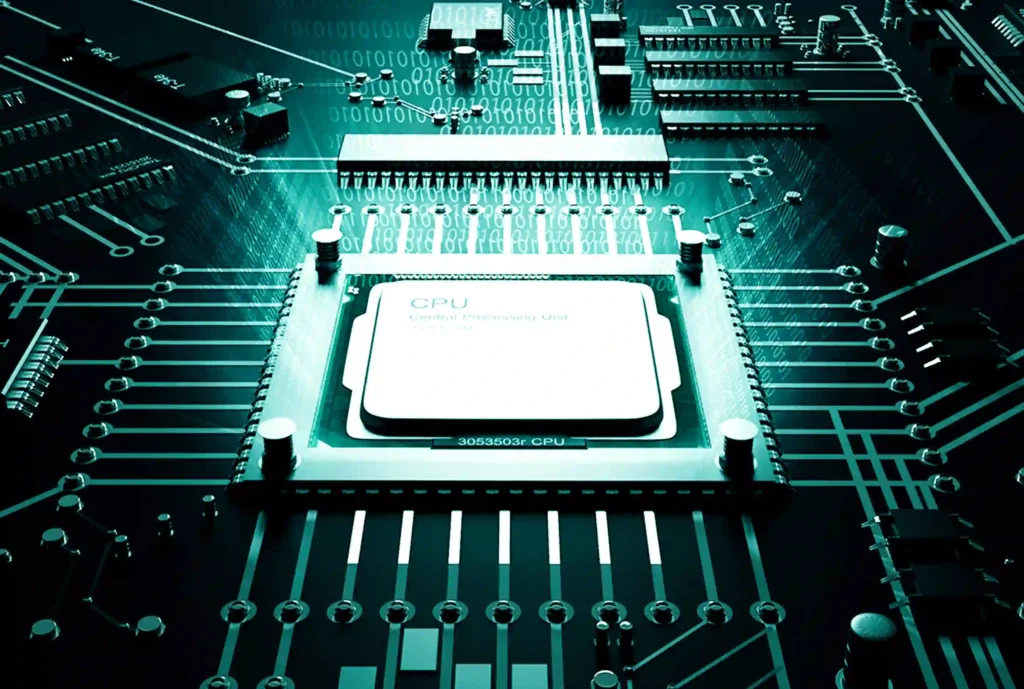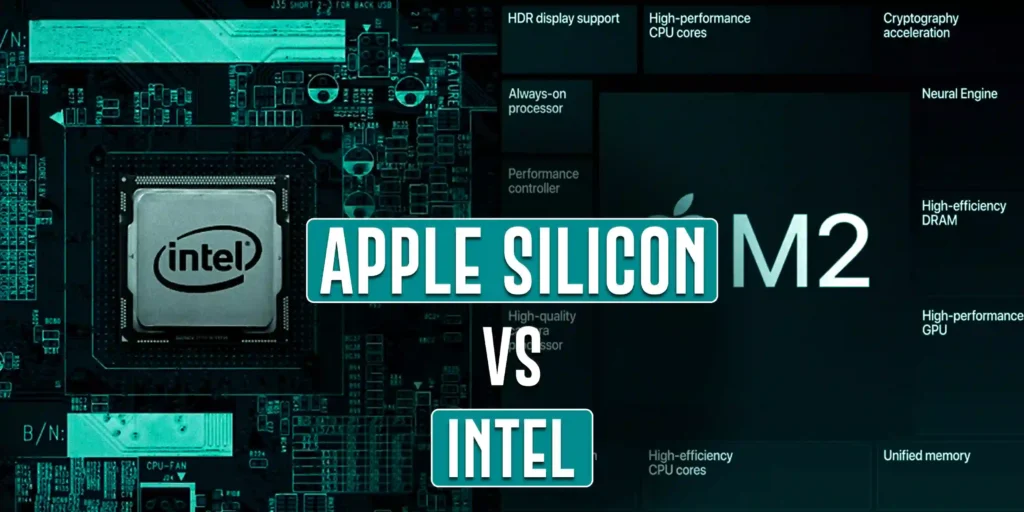We’ll analyse the differences between Apple Silicon and Intel CPUs, as well as their advantages and disadvantages, in this blog post to help you decide which one would be more suitable for your computer requirements.
Introduction
The competition between Apple Silicon vs Intel CPUs in the computing world has attracted interest from both customers and tech enthusiasts.
Since Apple shifted to its own specially developed silicon chips, there has been a greater discussion about which processor is better.

Understanding Apple Silicon and Intel Processors
Apple Silicon
It is the term used for the specially crafted CPUs that Apple develops for its Mac series. These ARM-based chips are well-known for their effectiveness, speed, and connectivity with macOS.
The neural engine for machine learning activities, a single memory architecture, improved safety features, and efficient power management are some of it’s key characteristics.
It’s processors are suitable for jobs like video editing, app development, and general computing duties because they maintain a mix between performance and energy economy.
Intel Processors
But Intel processors have long been the preferred option in the PC business. These processors, which are commonly found in Windows-based laptops and desktops, are built on the x86 architecture.
High performance, wide software program compatibility, and strong multitasking are features common to Intel processors.
Turbo Boost technology, which increases clock rates, integrated graphics options, support for virtualization, and enterprise-level computing are some of the key features of Intel processors.
Performance Comparison
CPU Performance
- The company’s move to exclusive silicon generated significant improvements in CPU performance. Recent Apple silicon chips, such as the M1 and M1 Pro/M1 Max, match and sometimes outperform Intel’s top-tier products in terms of single- and multi-core performance.
- Single-core activities that require a single-threaded workload benefit heavily from Intel processors’ robust single-core performance. However, Apple Silicon made major improvements in multi-core performance and power efficiency.
GPU Efficiency
- Major improvements have been made to the built-in GPU (Graphics Processing Unit) in Apple Silicon chips, which provides smooth graphics performance for applications like graphic design, gaming, and video editing.
- While the company’s integrated graphics have improved over time, they remain short of dedicated GPUs and Apple Silicon Chips’ integrated graphics solutions.
Battery Life
- Like its Intel-based predecessors, Apple Silicon is defined by its energy efficiency, which improves the battery life of MacBooks and other Apple devices.
- While Intel processors have improved their power management, they require more power, which means that laptops and other portable devices’ batteries take a shorter time.
Software Compatibility
Compatibility with macOS
- Using Rosetta translation technology, Apple has customized macOS to work smoothly on Apple Silicon processors, ensuring compatibility with the great majority of Mac programs.
- MacOS has always supported Intel CPUs, which can run a variety of software programs, including those from the past that could have not been designed for Apple Silicon.
Compatibility with Windows
- Even though programs like Parallels Desktop and Boot Camp can provide some level of compatibility, running Windows on Macs built on Apple Silicon is not officially supported.
- Windows apps can be run natively on Windows-based PCs because of Intel chips’ complete compatibility with Windows operating systems.
Future Prospects
Apple’s Silicon Roadmap:
With its roadmap defining the process of moving the whole Mac portfolio to Apple Silicon, Apple has shown its dedication to continuous development and enhancements in terms of speed, effectiveness, and macOS integration.
Intel’s Reaction:
To compete with Apple Silicon and other competitors, Intel keeps coming out with new processor technology and focusing on areas like AI acceleration, 5G connection, and improvements in manufacturing techniques.
Which Processor is Better for You?
Selecting between CPUs from Apple Silicon and Intel is based on specific factors:
Requirements for Use:
It can be a better option if performance, energy efficiency, and compatibility with macOS are your top priorities. This is particularly true for applications like video editing, software development, and content creation.
Intel processors continue to be a good option for customers who need virtualization, enterprise-level computing capabilities, and connectivity with a large variety of software programs.
Preference of Ecosystem:
Think about your software preferences and current ecosystem. If you use Apple’s network of apps and services regularly, it provides smooth efficiency and integration.
Intel processors provide more compatibility if you use Windows-based apps most of the time or if you need specific software that isn’t yet designed for Apple Silicon.
Future Proofing:
Think about your long-term computer requirements as well as the possibility of future software updates and optimizations. Your choice can be affected by Apple’s dedication to developing Apple Silicon technology and designing macOS for these chips.
FAQS
Higher performance-per-watt, better power management for longer battery life, integrated graphics with improved performance, and better interaction with macOS for an effortless user interface are some of the main advantages of Apple silicon.
Yes, Apple has made macOS more suitable for use with Apple silicon chips. Rosetta translation technology ensures that many Mac programs are compatible with Apple Silicon, providing an effortless upgrade for customers.
Official support for running Windows on Apple Silicon-based Macs has been removed. On the other hand, programs like Boot Camp and Parallels Desktop can only be fully compatible with Windows.
Conclusion
In the battle between Apple Silicon and Intel, each CPU has advantages and disadvantages. While Intel CPUs provide enterprise-level computing capabilities and compatibility with a wide range of software, it provides amazing performance, energy efficiency, and close interaction with macOS. The ideal processor for you is going to depend on your software compatibility needs, ecosystem preferences, and use requirements. To make sure that the choice you select satisfies your computing demands, carefully consider these criteria.
